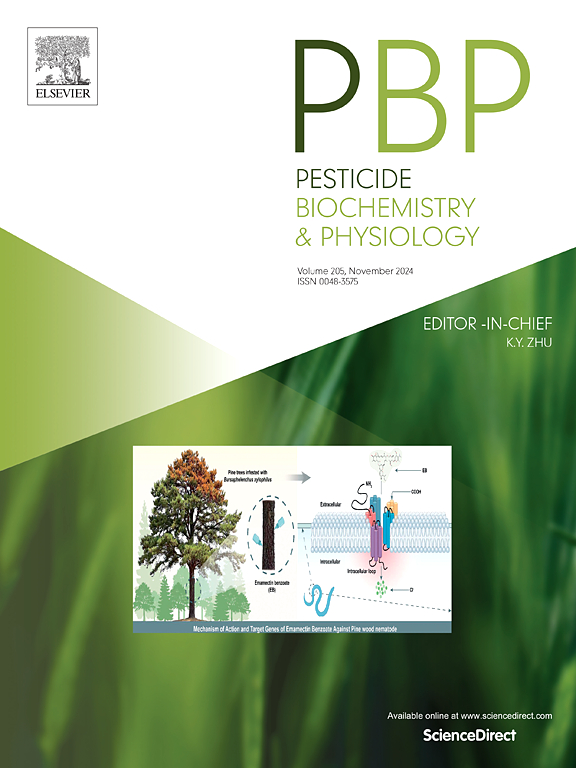The nematicidal activity of Bacillus thuringiensis Cry1Ia36 expressing in Escherichia coli
IF 4.2
1区 农林科学
Q2 BIOCHEMISTRY & MOLECULAR BIOLOGY
引用次数: 0
Abstract
Plant-parasitic nematodes (PPNs) are a significant threat to numerous agricultural crops. Biocontrol is an effective and safe method of the managing PPNs. Bacillus thuringiensis (Bt) and its parasporal crystal proteins (ICPs) are important biocontrol resources for PPNs. In this study, the 2160-bp cry1Ia36 gene from the Bt YC-10 strain was expressed in Escherichia coli and the 81-kDa protein was purified. The nematicidal activity test yielded an LC50 of 12.79 mg/L at 96 h for the second stage juveniles (J2s) of Meloidogyne incognita, and the Cry1Ia36 protein exhibited a pronounced inhibitory effect on the infection of M. incognita to cucumber roots with the pot experiment, which the control effect was 76.95 % treated with 40 mg/L Cry1Ia36. Transgenic tomatoes that expressed the cry1Ia36 gene exhibited efficient control of M. incognita, showing a notable reduction in the number of galls and eggmasses compared to the control. Subsequent transcriptome analysis revealed substantial alterations in the expression patterns of numerous genes in M. incognita J2s treated with Cry1Ia36 protein. Furthermore, the yeast two-hybrid analysis and pull-down assays demonstrated an interaction protein in M. incognita and the interaction protein is associated with the nematicidal activity of Cry1Ia36. Consequently, these findings suggest that the Cry1Ia36 protein could be a promising nematicidal agent for the control of PPN diseases, which offers a viable alternative to chemical pesticides because of its association with environmental concerns, although no previous reports have been found that demonstrate its activity against PPNs. Concurrently, this study has also expanded the spectrum of Bt ICPs.

苏云金芽孢杆菌Cry1Ia36在大肠杆菌中表达的杀线虫活性
植物寄生线虫(PPNs)是对许多农作物的重大威胁。生物防治是一种有效、安全的防治ppn的方法。苏云金芽孢杆菌(Bacillus thuringiensis, Bt)及其拟孢晶体蛋白(parasporal crystal protein, ICPs)是防治PPNs的重要生物资源。本研究在大肠杆菌中表达了来自Bt YC-10菌株的2160 bp cry1Ia36基因,并纯化了81 kda蛋白。在盆栽试验中,Cry1Ia36蛋白对黄瓜根线虫侵染有明显的抑制作用,40 mg/L Cry1Ia36对黄瓜根线虫侵染效果为76.95%。表达cry1Ia36基因的转基因番茄表现出有效的控制隐性m.a cognita的效果,显示出与对照相比,瘿和卵的数量显著减少。随后的转录组分析显示,使用Cry1Ia36蛋白处理的M. incognita J2s中许多基因的表达模式发生了实质性的变化。此外,酵母双杂交分析和pull-down实验表明,M. incognita中存在一个互作蛋白,该互作蛋白与Cry1Ia36的杀线虫活性有关。因此,这些研究结果表明,Cry1Ia36蛋白可能是一种很有前途的杀线虫剂,用于控制PPN疾病,由于其与环境问题相关,它提供了一种可行的替代化学农药的方法,尽管之前没有发现证明其对PPN有活性的报道。同时,本研究还扩展了Bt icp的频谱。
本文章由计算机程序翻译,如有差异,请以英文原文为准。
求助全文
约1分钟内获得全文
求助全文
来源期刊
CiteScore
7.00
自引率
8.50%
发文量
238
审稿时长
4.2 months
期刊介绍:
Pesticide Biochemistry and Physiology publishes original scientific articles pertaining to the mode of action of plant protection agents such as insecticides, fungicides, herbicides, and similar compounds, including nonlethal pest control agents, biosynthesis of pheromones, hormones, and plant resistance agents. Manuscripts may include a biochemical, physiological, or molecular study for an understanding of comparative toxicology or selective toxicity of both target and nontarget organisms. Particular interest will be given to studies on the molecular biology of pest control, toxicology, and pesticide resistance.
Research Areas Emphasized Include the Biochemistry and Physiology of:
• Comparative toxicity
• Mode of action
• Pathophysiology
• Plant growth regulators
• Resistance
• Other effects of pesticides on both parasites and hosts.

 求助内容:
求助内容: 应助结果提醒方式:
应助结果提醒方式:


